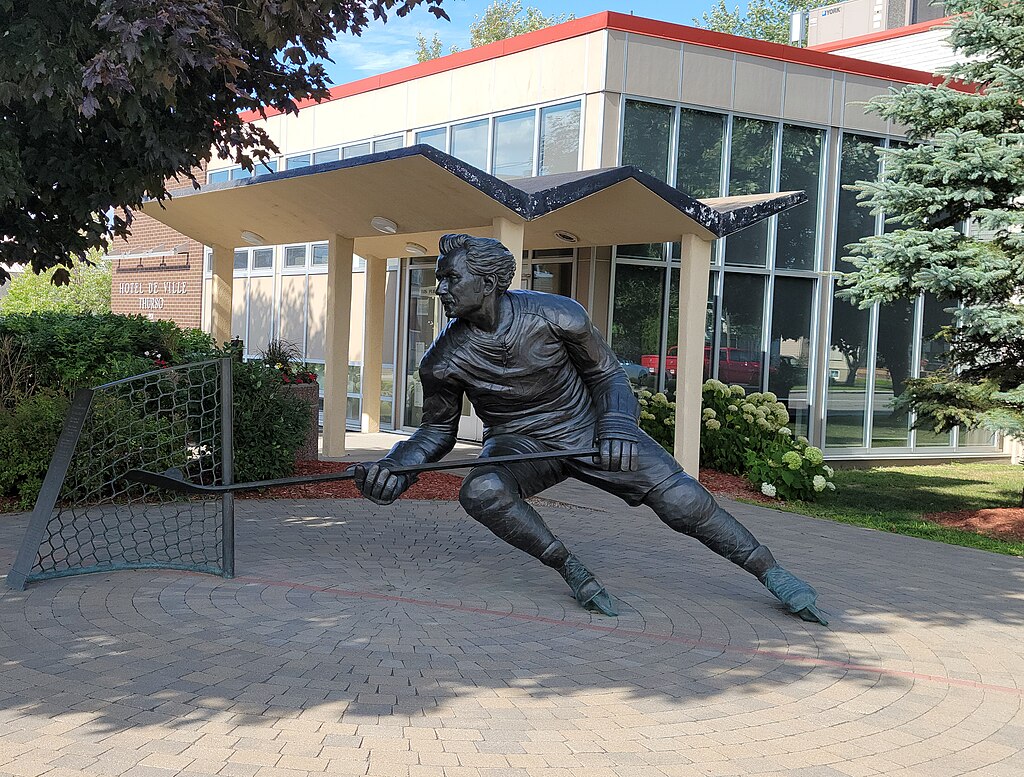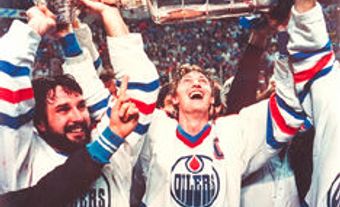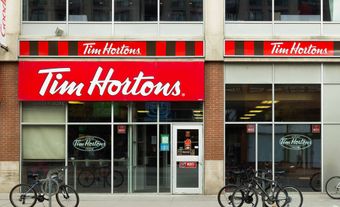Childhood
Guy Lafleur was born on 20 September 1951 in the pulp mill town of Thurso, Québec, along the Ottawa River. He has four sisters and was the only son born to Réjean and Pierrette Lafleur.
At the age of five, Lafleur was given his first pair of hockey skates and a hockey stick as Christmas presents. His father built an ice rink behind the family home every winter. Other children in the community were invited to play hockey on the rink with the condition that they would let him play with them.
Lafleur’s passion for hockey ran deep. At the age of seven, he slept in his hockey equipment so that he could start playing first thing in the morning. He would play hockey before school, at noon against other classes and after school against other teams in the area. In Lions in Winter (1987), he told authors Chrys Goyens and Allan Turowetz, “All I know is that by the time I was seven or so, I was taking hockey more seriously than some of my friends.”
At the age of nine, Lafleur worked on a friend’s farm to stay in shape. He also ran regularly to help improve his endurance. His father even built barbells so he could work on his strength.
Lafleur was raised in a community that shared his passion for hockey. This included the principal and teachers at his local school: One of his teachers exempted him from homework if he had an away game. When Lafleur was 10 years old, the manager of the local hockey arena offered him extra ice time in return for completing various chores at the arena.
Québec Pee-Wee International Tournament
In 1962, at the age of 10, Lafleur participated in his first Québec Pee-Wee International Hockey Tournament in Québec City. The tournament was established in 1960 and is now considered the most prestigious youth hockey tournament in the world. In 1962, it involved about 1,200 players from across North America.
At the time, Lafleur was playing for a travel team based in Rockland, Ontario (about 30 kilometres south of Thurso, on the other side of the Ottawa River), often against players that were two years older than he was. Lafleur scored 30 of his team’s 48 goals, including seven goals in one game on 5 February 1962.
In recognition of his outstanding performance, Lafleur was named most valuable player of the tournament. Another highlight for Lafleur was meeting Jean Béliveau, who was captain of the Montreal Canadiens at the time. After Lafleur registered a hat trick in one game, Béliveau placed a hat on the young player’s head.
Lafleur played at two more Québec Pee-Wee International Hockey Tournaments in 1963 and 1964, this time with a team from Thurso. He scored 64 goals over three years, leading his team to the “C” championship title each season.
Junior Hockey
When he was 15 years old, Lafleur moved from Thurso to Québec City to join the Quebec Jr. Aces of the Québec Junior A Hockey League. The Aces had had their eye on Lafleur since seeing him play at the Québec Pee-Wee International Hockey Tournament. Paul Dumont, the tournament’s director, was also a scout for the Aces. The first time he watched Lafleur play, he made the following notes: “Excellent skater. Strong and accurate right-handed shot. Interesting style of play. Can fake right or left. Excellent forward, can also play defensively.”
Lafleur played three seasons for the Aces, followed by two seasons with the Quebec Remparts of the Quebec Major Junior Hockey League. During Lafleur’s first season with the Remparts (1969–70), he set the record for most goals (103) in a Canadian major junior hockey league season; the following season, he broke his own record when he scored 130 goals, and he also set the record for most points (209) — Mario Lemieux currently holds the record for most goals (133) and points (282) in a major junior hockey season, which he set while playing with the Laval Voisins in 1983–84. Lafleur finished the season by leading the Remparts to their first Memorial Cup title.
The Montreal Canadiens liked what they saw of Lafleur and selected him first overall in the 1971 NHL Amateur Draft on 22 May 1970.
NHL Career
In his first three seasons in Montréal, Lafleur’s statistics were considered average (175 points in 215 regular season games), and he struggled to meet the high standards expected of him. However, in his fourth season, in 1974–75, Lafleur broke the Canadiens’ record for most goals (53), assists (66) and points (119) in one season. On 7 March 1975, Lafleur became the first Canadiens player in franchise history to notch 100 points in a single season, in an 8–4 win over the Washington Capitals.
Over the next five seasons (1976–80), Lafleur continued to be excellent at right wing and was known for his fluid skating style, instinctive playmaking and accurate shots. From 1976 to 1980, Lafleur registered at least 50 goals and 125 points each season. He still holds the Canadiens’ record for most points in a regular season (136), set in 1976–77, and is tied with Steve Shutt for most goals in a regular season by a Canadiens player (60), set in 1977–78.
During those five seasons, Lafleur won the Art Ross Trophy three times (1976–78), the Hart Trophy twice (1977–78), the Lester B. Pearson Award (now the Ted Lindsay Award) three times (1976–78), the Conn Smythe Trophy (1977), the Lou Marsh Trophy (1977) and the Lionel Conacher Award (1977). He also guided the Montreal Canadiens to four consecutive Stanley Cups from 1976 to 1979.
During his time with the Canadiens, Lafleur was chosen for the NHL’s First All-Star Team six times (1975–80), played in five NHL All-Star Games and led the NHL twice in playoff goals (in 1975 and 1978) and playoff assists (in 1977 and 1979) and three times in playoff points (in 1977, 1978 and 1979). In 1977, Lafleur set a Canadiens record for most assists in a single playoff season (17) — his record was tied the following year by defenceman Larry Robinson.
On 26 November 1984, Lafleur retired from the NHL. The Canadiens retired his number (10) on 16 February 1985. However, after he was inducted into the Hockey Hall of Fame on 7 September 1988, Lafleur decided to come out of retirement. On 26 September 1988, he signed with the New York Rangers and played three more NHL seasons: one season with the New York Rangers and two seasons with the Quebec Nordiques. In his final NHL season (1990–91), Lafleur played in his sixth NHL All-Star Game. He finished his career with 560 goals, 793 assists and 1,353 points.
Representing Canada
Lafleur played for Canada three times in his career: twice at the Canada Cup (in 1976 and 1981) and once at the 1981 IIHF Ice Hockey World Championships in Gothenburg, Sweden. Even though he was part of the Canadian team that won the 1976 Canada Cup, Lafleur played best at the 1981 Canada Cup, leading Team Canada in assists (9) and tying for second in the tournament in points (11) — one point less than Wayne Gretzky.
Honours
In 1985, the Guy Lafleur Awards of Excellence and Merit were established for hockey players who best combine excellence in hockey performance and academics. Players who participate in the Quebec Major Junior Hockey League, the Quebec Junior Hockey League and a Québec-based school in Canadian Interuniversity Sport are eligible to receive up to $6,000 in scholarships over a three-year period.

Lafleur was awarded the Officer of the Order of Canada in 1980 and was made a Knight of the National Order of Québec in 2005. He was also inducted into the Hockey Hall of Fame in 1988 and Canada’s Sports Hall of Fame in 1996. In 2002, Canada Post issued a 48-cent stamp in his honour.
Lafleur also had an affiliation with the Canadian military. He served as Honorary Colonel of 12 Radar Squadron (RCAF) between 2005 and 2008 and was appointed Honorary Colonel of 3 Wing Bagotville in 2013. Lafleur also visited the Canadian military in Afghanistan.

 Share on Facebook
Share on Facebook Share on X
Share on X Share by Email
Share by Email Share on Google Classroom
Share on Google Classroom



